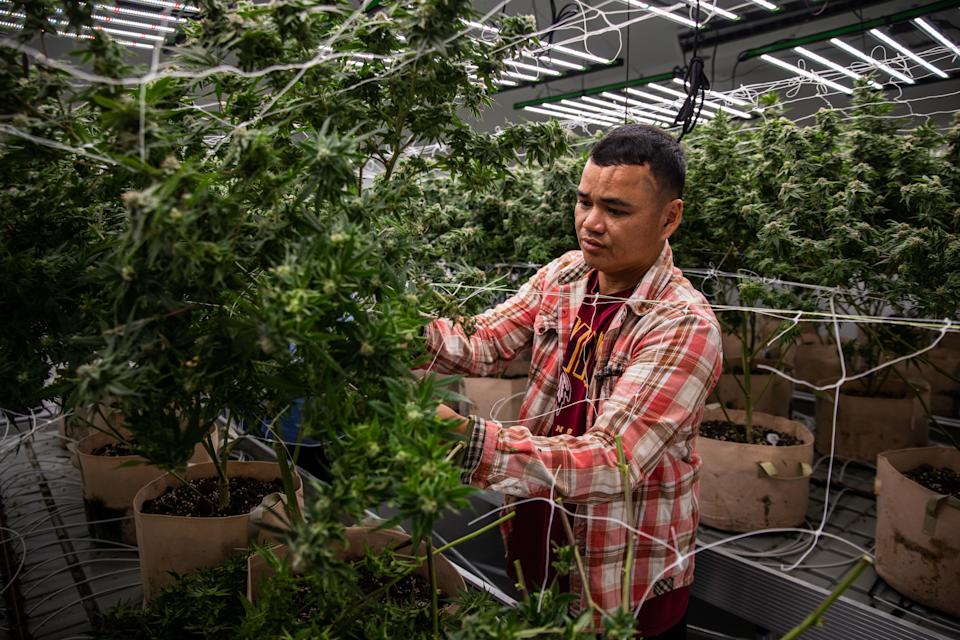Growing a Business Without a Bank: Inside the Financial Fight of Cannabis Entrepreneurs
Running a small business is rarely a walk in the park. But for entrepreneurs in the cannabis industry, it’s more like navigating a minefield — one where the rules keep changing.
Erin Gore knows this all too well. She’s the founder of Garden Society, a California-based cannabis brand, and on a recent episode of Yahoo Finance’s The Big Idea podcast, she laid bare the behind-the-scenes challenges that come with running a company in a legally gray zone. Speaking to host Elizabeth Gore — her sister-in-law — she described a financial landscape that’s more hostile than high-risk: no access to bank loans, no retirement plans for employees, and even personal bank accounts getting shut down without warning.
“What we don’t have is access to credit, and what we don’t have is services around it,” Gore explained. “We cannot get a 401(k). We can’t get a line of credit for payroll. We can’t even finance equipment. And that’s just the beginning.”
Despite the cannabis industry being valued at $38.5 billion in 2024, federal classification of marijuana as a Schedule I drug means most traditional financial institutions want nothing to do with it. That leaves business owners like Gore in a bind — legally operating at the state level, but locked out of the financial infrastructure that most companies rely on.
Banking on Workarounds
Gore, like many cannabis entrepreneurs, has had to get creative. Without loans or credit, cash flow has become her lifeline.
One investor once asked her about her “cash-to-cash cycle” — essentially, how long it takes to earn back what you spend on a product. For her branded products, Gore said the best-case scenario is 160 days. That’s a long time to wait for money you’ve already spent.
So she found a smarter way: contract manufacturing. By producing cannabis products for other companies — and getting them to pay for materials and production upfront — she slashed her cash cycle and added a new income stream.
“It covered my overhead and allowed me to reinvest in my brand,” she said. “It made my business more resilient.”
Today, Garden Society is one of California’s leading cannabis companies, but the risks haven’t disappeared. Without bankruptcy protection — another casualty of the industry’s federal status — Gore had no safety net when one of her distributors went under, owing her nearly half a million dollars.
“I don’t have credit. I can’t go to a bank. I’m only dependent on investor contributions,” she said.
Policy in Progress
Gore isn’t just surviving the system — she’s trying to change it. After almost a decade in the industry, she’s spent years lobbying lawmakers at every level, pushing for policies that reflect the reality on the ground.
One such proposal, the SAFER Banking Act, was introduced in Congress in 2023 to give banks legal cover when working with cannabis companies in states where marijuana is legal. But the bill has stalled, like many before it.
“We’re building the plane and flying it at the same time,” Gore said. “No one is better suited than business owners to help shape the rules.”
Her journey highlights an industry full of potential, yet bogged down by outdated laws and red tape. For now, resilience, ingenuity, and adaptability are not just traits — they’re survival tools.
“People underestimate how open to change you need to be,” she said. “You have to be that creative to make it work.”
A Bigger Picture: Industry Growth, Health Trends, and Local Battles
The financial struggles faced by cannabis entrepreneurs like Erin Gore are just one part of the broader picture shaping the industry in 2025. Shifts in consumer behavior, for example, are influencing how companies approach branding and product development — as highlighted in our deep dive into gender differences in marijuana use. Meanwhile, the market for medical cannabis continues its upward trajectory, with projections pointing to massive growth by 2030, creating opportunities — and complications — for both investors and patients. And as legalization expands geographically, local challenges like New Mexico’s cannabis-linked water rights crisis show how environmental and regulatory issues are becoming central to the sustainability of the industry.
FAQ – Cannabis Business and Finance
Q1: Why don’t cannabis companies have access to traditional banking services?
A1: Despite legalization in many U.S. states, cannabis remains classified as a Schedule I drug federally. This discourages banks from working with cannabis companies due to potential penalties and compliance concerns under anti-money laundering laws.
Q2: What is the SAFER Banking Act and how would it help cannabis businesses?
A2: The Secure and Fair Enforcement Regulation (SAFER) Banking Act is proposed legislation that would protect banks and credit unions that provide services to cannabis businesses operating legally under state laws. If passed, it could open the door to loans, credit, and financial stability for the industry.
Q3: How do cannabis businesses manage cash flow without credit or loans?
A3: Entrepreneurs often rely on creative strategies like contract manufacturing, investor funding, and tight cash-cycle management. Some, like Garden Society’s Erin Gore, also diversify income streams and reduce operational lag times to keep their companies afloat.
Q4: Are financial challenges the same across all U.S. states where cannabis is legal?
A4: No. While federal restrictions apply nationwide, each state has its own regulations that can either ease or complicate business operations. For example, environmental factors like water rights in New Mexico add a unique layer of complexity for growers in the Southwest.

